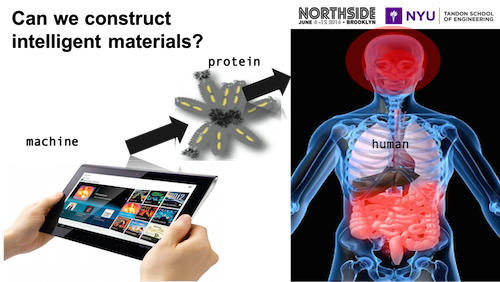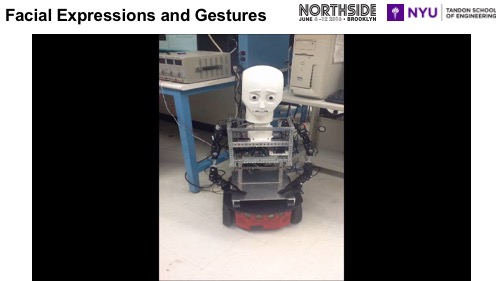Tandon Tech in Service to Society
Brooklyn’s 2016 Northside Festival Showcased Tandon Faculty and Their Research
Over the last few years, Brooklyn and Innovation have become inextricably linked. From the rising Maker Movement that has organically sprouted in Greenpoint and has been supported by the Navy Yard to start-ups that have established footholds in Dumbo (and increasingly in Sunset Park), the borough has embraced the new manufacturing movement and is using technology as its vehicle.
The Northside Festival, in its 7th year, has consistently looked to draw upon the hipster revolution by mixing music, art, and technology into a weeklong event that celebrates the Brooklyn renaissance. And any discussion of the technological rebirth occurring in the borough would not be complete without faculty from the NYU Tandon School of Engineering, who are driving much of that action.
A hundred guests packed into Oleanders, a venue along McCarren Park, to listen to Assistant Professor of Computer Science and Engineering Justin Cappos, Associate Professor of Chemical and Biomolecular Engineering Jin Kim Montclare, and Professors of Mechanical and Aerospace Engineering Vikram Kapila and Maurizio Porfiri discuss passwords, fish, intelligent proteins, and mechatronics — and describing how their research is creating technology to be used in service to society.
The program started with an overview of NYU Tandon, which has had Technology in Service to Society as part of its ethos since its inception in 1854 and has remained steadfast to that mission throughout six name changes. The phrase “American Dream” was coined by a Tandon alum, and we’re still celebrating the opportunity for every person to achieve their goals, regardless of social position or background.
The crowd was subsequently captivated by the discussions of proteins being engineered in labs to help deliver therapeutic treatments to cells; the simple way websites can help ensure that your passwords are protected; how robotic fish can lead schools of live fish out of danger (and how we can study fish patterns to better understand nature and ourselves); and the ways in which robots can aid people with disabilities.
A few snippets from the conversation:
Justin Cappos
In just minutes, a single computer hacker armed with a laptop can crack a handful of six-character passwords, no matter how much thought you’ve put into it. And if you’re using something that took no thought at all, like ILoveYou or LetMeIn, which I really hope you’re not doing, it’s even easier. I’ve developed a method that makes it very difficult for would-be hackers because it would require them to crack groups of passwords simultaneously — an almost impossible task — in order to verify any single password. It’s open source, so anyone here who has a start-up or site can just come to me to learn more about using it. That’s one way I’m using technology to meet a societal need.

Jin Kim Montclare
You interact everyday with intelligent materials: your tablets and cellphones, for example, are intelligent in that they sense and respond to you. In my lab, I also work with intelligent materials — but with a twist, because I use biology to generate them. The proteins within your body can be engineered in such a way that they can deliver therapeutic drugs or gene therapy. That’s what I do, so chemical and biomolecular engineers like me can serve society by using technology to help heal disease.

Vikram Kapila
I work in the area of mechatronics, which is a multidisciplinary field combines systems engineering, mechanical engineering, electrical engineering, computer engineering, and more. In my lab, we’re serving society by working to make life better for those with disabilities. One of our projects, for example, is a humanoid robot named CAESAR, which interacts with people by tracking their movements and recognizing and mimicking their facial expressions. We think he’ll be very useful in education and therapy for children with autism.

Maurizio Porfiri
I study collective behavior, and I’ve found that robotic fish can lead schools of real fish to mimic them, which would be useful in leading them away from pollution, power plants, or other hazards. We borrow designs from nature in order to build our robots, so why not use the robots to assist nature? I use zebra fish in my research, and it turns out that they share a lot of DNA with humans, so my work might eventually have an impact on behavioral brain research and neuropsychobiology.






